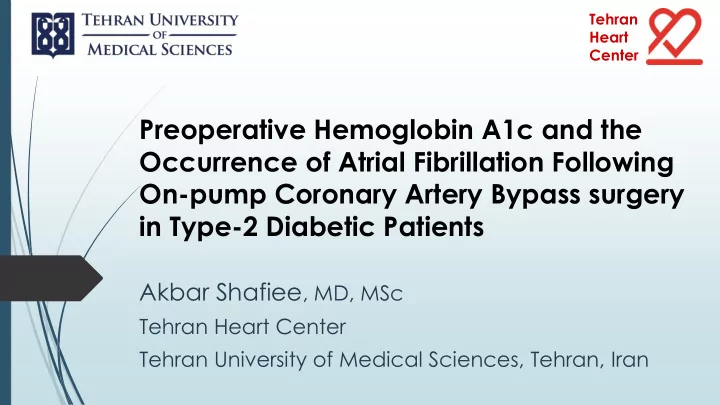

Tehran Heart Center Preoperative Hemoglobin A1c and the Occurrence of Atrial Fibrillation Following On-pump Coronary Artery Bypass surgery in Type-2 Diabetic Patients Akbar Shafiee , MD, MSc Tehran Heart Center Tehran University of Medical Sciences, Tehran, Iran
Atrial Fibrillation 2 The most common type of arrhythmia Characterized by rapid and irregular beating
Atrial Fibrillation 3
Post-operative Atrial fibrillation (POAF) 4 A frequent serious problem Associated with an increase in the length of hospital stay, morbidity, and mortality From 10% to 45% in various studies Known risk factors: older age, obesity, heart rate variability, hyperglycemia, hypertension, left atrial size and function, use of statins, and preoperative AF
Post-operative Atrial fibrillation (POAF) 5 Moderate-intensity blood glucose control after CABG can effectively improve clinical outcomes and reduce the incidence of POAF Data on the association of the magnitude of hyperglycemia, as detected by preoperative hemoglobin A1c (HbA1c) as a surrogate marker of glycemic control and its impact on the development of POAF is insufficient
Aim of the study 6 To investigate the association of the preoperative HbA1c with occurrence of POAF in a cohort of type-2 diabetic patients who underwent isolated CABG at our center.
Methods 7 Prospective cohort Enrolling type-2 DM patients, aged 40-80 years, who underwent elective CABG between March 2012 and March 2013 at Tehran Heart Center follow-up for developing POAF
Methods 8 Primary endpoint: Onset of atrial fibrillation following CABG
Methods 9 Exclusion criteria : (1) the presence of AF or atrial flutter before the surgery; (2) pacing rhythm; (3) treatment with amiodarone or other specific antiarrhythmic drug;
Methods 10 Exclusion criteria : (4) emergency operation; (5) prior or concurrent valve replacement surgery or prior other cardiac surgeries; (6) history of any chronic inflammatory disease, or malignancy;
Methods 11 Exclusion criteria : (7) chronic hepatic disease or end-stage renal insufficiency dependant on hemodialysis; (8) history of hemolytic anemia, or hemoglobinopathy ; (9) recent acute blood loss or blood product transfusion;
Methods 12 Exclusion criteria : (10) and any severe valvular disease in the preoperative echocardiographic evaluation.
Methods 13 Data collection: * Demography * Medical history * clinical and laboratory measurements, particularly blood glucose and Hb A1c
Methods 14 AF diagnosis: * 12-lead ECG before the surgery * Telemonitoring at ICU for 72 hours * Confirmation by ECG
Results 15 From a total of 740 recruited patients, 708 patients were eligible Mean age of the cohort was 60.8±8.7 years and 433 (61.2%) cases were men.
Results 16 109 (15.3%) patients developed POAF. most frequent on the 2 nd post-operative day (43 [39.4%] patients)
Results 17 patients with Hb A1c>8% had a longer duration of diabetes ( P <0.001), more males ( P =0.001), higher levels of serum creatinine ( P =0.001), larger left atrial size in the preoperative echocardiography ( P =0.002) But no significant difference regarding POAF (P=0.71)
P for trend 0.002 18
19 Table: Multivariable model for detecting the adjusted effect of hemoglobin A1c on the development of post operative atrial fibrillation Characteristic Odds ratio 95% CI P-value Age 1.04 1.01-1.06 0.001 COPD 4.66 1.41-15.39 0.012 Hypertension 1.67 1.06-2.65 0.027 Preoperative Cr 1.65 1.20-2.28 0.002 LA size 1.07 1.02-1.12 0.004 Full perfusion time 1.00 1.00-1.01 0.014
Conclusion 20 We observed an incidence of 15.3% for POAF in diabetic patients undergoing CABG. The development of POAF following CABG was associated with the age, hypertension, COPD, preoperative serum creatinine level, and LA size, but not the preoperative HbA1c level
Thank you Any question?
Recommend
More recommend